When we set out to master trolling motor thrust ratings for peak performance, understanding how to match thrust to boat size is just the beginning. Many factors come into play, such as environmental conditions and hull design, which can dramatically impact how much power we need. We've also got to weigh the balance between thrust and speed for efficiency. But how do we guarantee our motor delivers the necessary power without wasting energy? There are techniques and tips to explore that could help us optimize our setup, guaranteeing our days on the water are as smooth as possible. What's the secret formula?
Understanding Trolling Motor Thrust
Understanding trolling motor thrust is essential for any boating enthusiast looking to optimize performance on the water. When we delve into this topic, we discover how critical it's for bending nature's elements to our will, allowing us the freedom to explore both calm and challenging waters.
Thrust, measured in pounds, reflects a motor's power and dictates our ability to steer, accelerate, and maintain position in various conditions. However, thrust variability means that wind, currents, and water swells can change what's required in any given situation. The larger and heavier the boat, the more thrust is necessary to ensure satisfactory performance. These factors keep us on our toes, pushing those of us who crave freedom to adapt and guarantee our setup can handle the unexpected.
Additionally, motor durability plays a key role in selecting a trolling motor. A motor with insufficient thrust not only underperforms but also wears down faster, reducing its lifespan.
Calculating Thrust Requirements
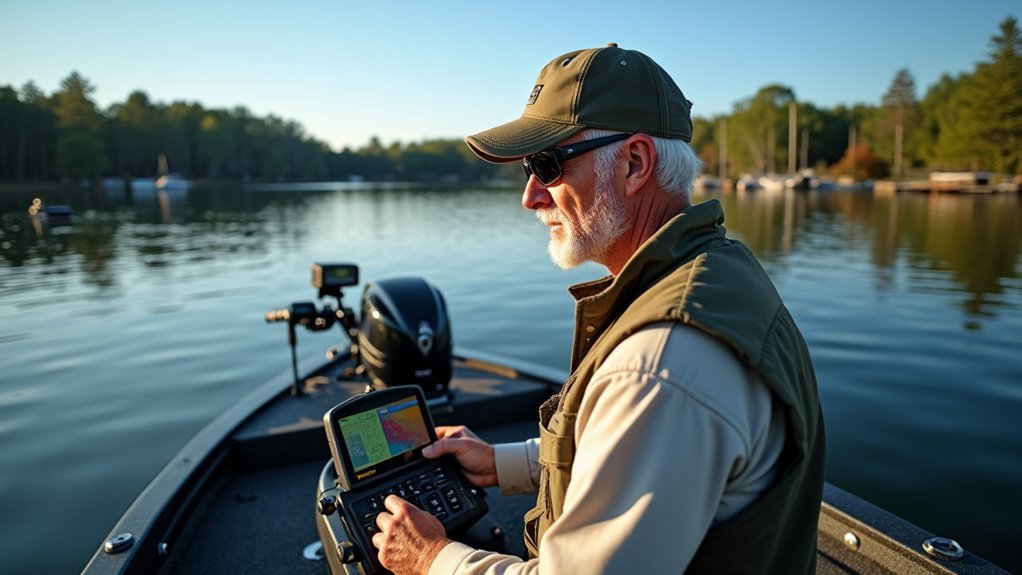
When determining the ideal trolling motor for our boat, calculating thrust requirements is essential for ensuring a seamless experience on the water. We need to think about the Thrust@SpringBootTest by understanding our boat's weight. The minimum rule is 2 pounds of thrust for every 100 pounds. For instance, a sample ThrustCalibration could look like this:
| Boat Weight | Recommended Thrust |
|---|---|
| 1,000 lbs | 20 lbs |
| 1,500 lbs | 30 lbs |
| 2,000 lbs | 40 lbs |
Next, let's address drag and resistance. A boat with a deep-V hull will need more thrust than a flat-bottom one due to increased water drag. Air drag on pontoon boats is another area to factor in, especially in windy conditions. Boats with large deck areas above the waterline often experience significant air drag, demanding extra thrust for optimal performance. Proper shaft length is important too, as incorrect length can lead to cavitation.
Moreover, motor voltage is key. Higher voltage motors provide more thrust. For example, 12v motors use one battery, while 24v and 36v motors require more.
Ensuring our trolling motor has adequate thrust will also make our steering responsive and maintain a comfortable cruising speed, ideally around 3-4 mph. With this understanding, we'll be ready for any adventure.
Matching Thrust to Boat Size
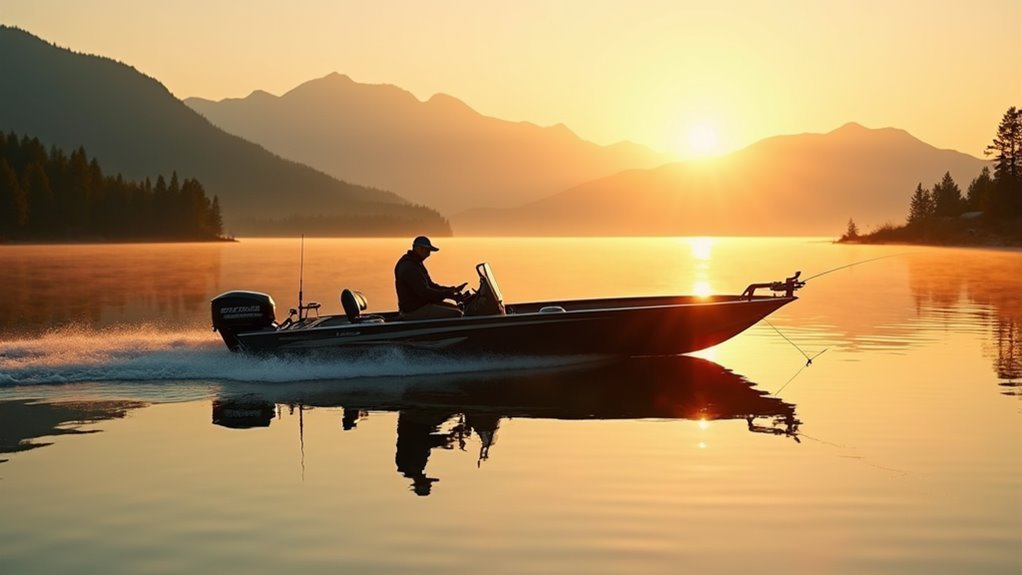
Selecting the right trolling motor for your boat can feel a bit like art mixed with science. We need to guarantee the perfect harmony between boat stability and hull design for peak performance. Understanding our boat's weight is vital. It includes everything from the dry weight to equipment, gear, and passengers. As a rule of thumb, we should aim for at least 2lbs of thrust for every 100lbs of boat weight. This balance guarantees that we're not left struggling against the currents or caught off-guard by sudden swells. When choosing a motor, it's crucial to ensure the propeller is positioned at least 1 foot under the water for optimal performance and efficiency. If we're piloting a smaller boat, perhaps 1,500lbs or less, 30lbs of thrust should suffice. For medium-sized vessels around 2,000lbs, 40-45lbs provides the right punch. As we venture into larger waters with boats flirting around 4,000lbs or more, 80lbs, or even up to 112lbs for the heaviest boats, keeps us gliding smoothly. Different types of hull designs influence the drag generated, impacting our thrust needs. Center console boats, for instance, often demand more thrust due to design-induced drag. Considering these factors guarantees we're as prepared and free on the water as we dream to be.
Battery Power and Thrust
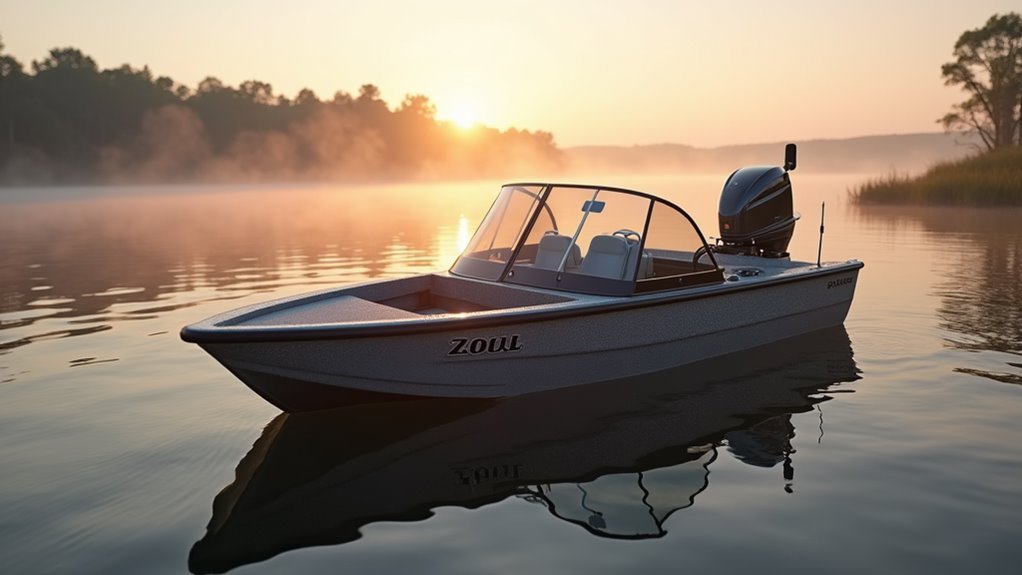
Let's explore the mechanics of battery power and thrust, which are crucial for any trolling motor setup. When we think about exploring open waters with a trolling motor, the right battery types and voltage optimization are key to maintaining freedom and performance.
Our goal is to guarantee that we've the power needed for our particular motor, without being tethered to any limitations.
The longevity and efficiency of a trolling motor largely depend on the type of battery used, underscoring the significance of maintenance and regular inspections to ensure optimal performance. Let's paint a clearer picture with these points:
- Less than 55 lbs thrust needs a single 12-volt battery.
- 55-80 lbs thrust demands 24 volts, which means two 12-volt batteries.
- More than 80 lbs thrust pulls power from three 12-volt batteries for 36 volts of force.
- LiFePO4 Lithium Ion batteries adapt easily to 12, 24, or 36-volt systems.
High-quality batteries keep the engine running smoothly, providing us with that exhilarating feeling of control and flexibility on the water.
Choosing between a deep-cycle lead-acid or a more advanced lithium battery affects how long we can roam before needing a recharge. Higher voltage systems remarkably cut down on amp draw, enhancing our journey's efficiency.
We optimize each cruising adventure by picking the right setup, guaranteeing an escape that's as limitless as the horizon.
Impact of Water Conditions

Understanding how water conditions impact our trolling motor's thrust can make the difference between smooth navigation and a challenging outing. We've got the freedom to explore vast waters, but we need to account for factors like water resistance and wave impact. Windy days may demand increased thrust to maintain our desired course. Meanwhile, strong currents, particularly in river settings, challenge us to keep our position. The ability to maintain control on larger, heavier boats necessitates higher thrust to tackle these conditions effectively. Let's explore how these elements play out:
| Condition | Challenge | Required Action |
|---|---|---|
| Windy | Steering off course | More Thrust |
| Strong Currents | Maintaining speed and position | Extra Thrust |
| Shallow Water | Increased drag resistance | Adjust Motor |
| Swells and Tides | Boat stability | Boost Power |
The wind can be relentless, making control a bit of an adventure, while strong currents, especially during fishing escapades, challenge our motor's endurance. If we don't prepare for these, our motor could strain, reducing its lifespan. Not all boats are equal—pontoon boats, flats boats, each has its quirks. But with the right thrust adjustments, we'll tackle water resistance and wave impact with ease, ensuring our adventures are nothing short of exhilarating.
Thrust vs. Speed: The Balance
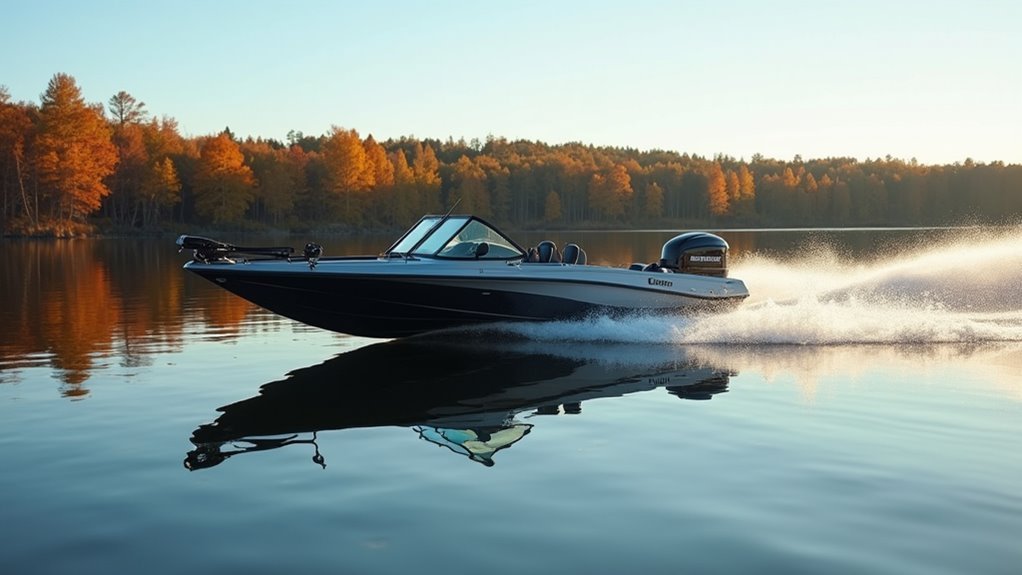
When we strike the right balance between thrust and speed, our boating experience becomes exponentially more enjoyable and efficient. By paying attention to factors like propeller balance and motor noise, we can achieve a seamless glide on the water. Hull drag significantly affects the performance of trolling motors, so it's crucial to select the right motor to handle the increased load on larger vessels. Thrust, measured in pounds, is the power needed to propel and steer our vessel, especially against the forces of wind or current. However, it's vital to remember that simply increasing thrust doesn't always mean our boat will go faster. Instead, it's akin to the pull and twist like a car's torque.
- Right propeller balance guarantees smooth movement without unnecessary strain on the motor.
- Excessive motor noise can indicate an imbalance or inefficiency we need to address.
- True speed comes from overcoming drag, not just adding thrust.
- Performance tweaks, like adjusting the propeller, offer superior control and speed.
For freedom-loving boaters like us, understanding the thrust-to-speed dynamic empowers us to make informed choices. This includes selecting the right motor and tuning it for peak performance.
Whether it's finding the sweet spot for thrust or enjoying the serene sounds of nature over a noisy motor, balance is key.
Choosing the Right Shaft Length
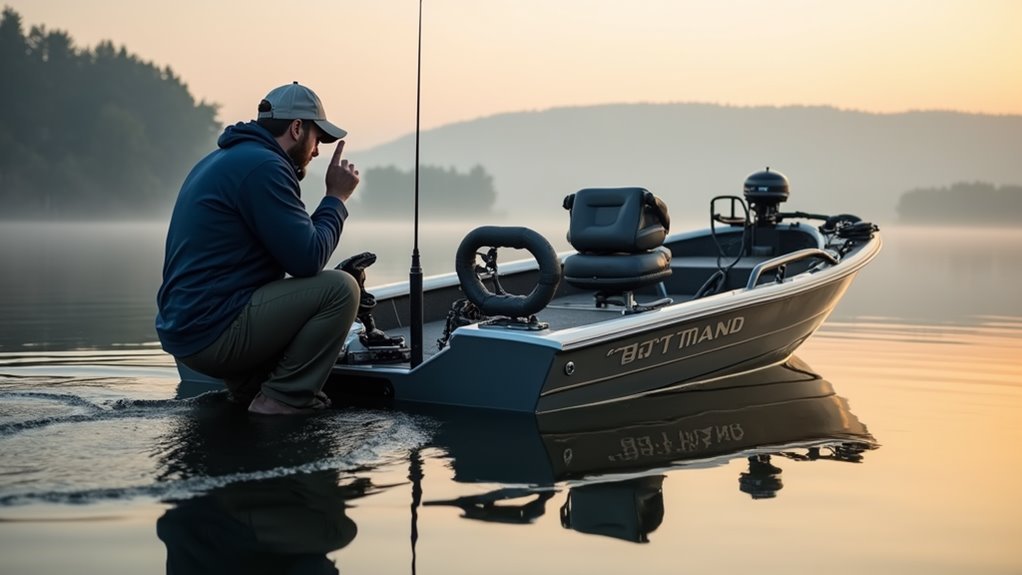
Choosing the Right Shaft Length
Selecting the right shaft length for our trolling motor is crucial for peak performance and efficiency on the water. We should start by measuring the distance from the mounting surface to the waterline, adding 18-22 inches for bow mounts and 20 inches for transom mounts. This guideline guarantees our motor stays properly submerged, even in choppy conditions. Remember, going longer is better because we can always adjust the shaft upwards, while a short shaft limits us and can cause cavitation. Ensure there is ample space at the bow for mounting, as some pontoon boats may require alterations to fit the motor properly.
Mounting options play a big role too. We need to decide if we're mounting on the bow, transom, or alongside the main motor. Each position might call for different shaft lengths based on deck height and water conditions.
For those with pontoon boats, common shaft lengths like 55" or 60" work well, but a 48" might suffice depending on the setup. Shaft materials also matter. We should choose sturdy materials to withstand rough waters, especially if we're planning on some ocean adventures. Finding the right balance in shaft length helps us enjoy the water with greater freedom, guaranteeing our trolling motor performs at its best.
Maximizing Battery Efficiency
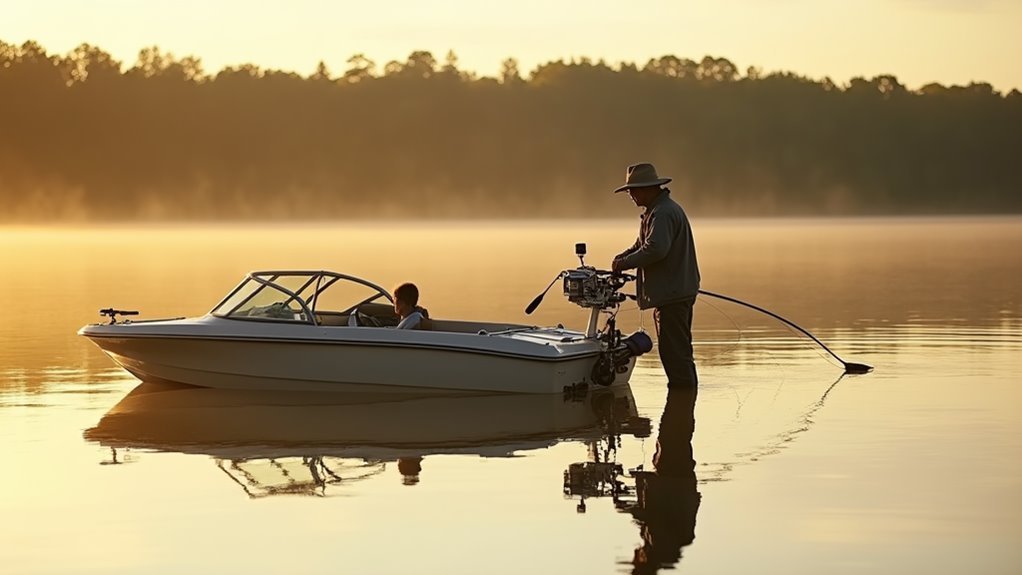
First off, selecting the right battery plays a crucial role. Deep cycle batteries with high ampere-hour (Ah) ratings give us more runtime, ensuring longer adventures. Though lithium batteries might initially cost more, they offer a longer lifespan and impressive runtime. Group 24 batteries are a popular choice for many trolling motors due to their adequate power supply and optimal balance of size and capacity.
Let's shift focus to efficient usage. By monitoring the battery and managing speed, we can conserve energy and extend our time on the water. It's wise to adjust thrust based on boat weight and controlling conditions, keeping idle time to a minimum to prevent unnecessary drain.
For those of us who love freedom, understanding charging cycles is essential. Proper charging methods prevent battery overcharging or undercharging, both of which can impact battery health.
Here's what to take into account:
- Recharge promptly after use.
- Use suitable chargers for deep cycle batteries.
- Avoid offseason battery neglect, use trickle chargers.
- Prevent stratification by occasionally fully discharging and recharging.
Maintenance for Optimal Thrust

Having maximized our battery efficiency, let's now guarantee our trolling motor operates at peak performance by focusing on maintenance for maximum thrust. To do this, propeller cleaning is essential. We should gently remove any debris and gunk from behind the propeller. This simple act wards off drag and unwanted motor wear.
Let's not forget our trusty 1/2" socket and ratchet to carefully remove and clean the prop, making sure to handle the prop pin gently so it stays safe and snug. With everything inspected, we've gotta guarantee the propeller drive pin is tightened correctly.
Moving on, shaft lubrication keeps our motor running smoothly. A dab of lubrication on the tungsten shaft reduces friction, helping prevent overheating. Regular cleaning(with a soft-bristled brush) of the shaft ensures that debris does not cause damage over time. While we're at it, giving the motor housing a once-over helps sidestep any electrifying issues or heat problems.
Making sure our shaft aligns perfectly and checking for damage on both shaft and housing stops unexpected breakdowns, leaving us more freedom to explore.
Finally, securing mounting bolts, and tightening battery connections maintain the motor's power and performance. Let's keep these simple tips in mind, and we'll revel in top-notch thrust all season long.
Frequently Asked Questions
How Does Temperature Affect Trolling Motor Thrust Performance?
We are aware that temperature affects trolling motor thrust due to air density, causing reduction. Let's manage heat effectively to prevent friction, ensuring peak performance. Proper attention empowers us to push boundaries and explore without limits on the water.
Are There Eco-Friendly Options for Trolling Motors?
Let's explore eco-friendly trolling motors together. They're crafted from sustainable materials and powered by eco-friendly batteries. Imagine the freedom of silent navigation with zero emissions, protecting our waters, while embracing innovation and sustainability for the environment's sake.
Can Saltwater Negatively Impact Trolling Motor Thrust Ratings?
Saltwater can impact trolling motor thrust by causing corrosion risks and reducing material durability. Let's guarantee our adventure remains free by understanding these challenges and opting for corrosion-resistant materials that enhance performance and longevity in marine environments.
What Technological Advancements Exist in Trolling Motor Thrust Systems?
We've seen amazing progress in trolling motors with advanced materials and silent operation. Innovations like brushless tech, GPS integration, and high-strength designs offer freedom on the water, ensuring peak performance even in challenging conditions. Let's explore these advancements together!
How Do Manufacturer Warranties Cover Thrust-Related Issues?
We check warranty terms carefully since claim procedures vary, affecting coverage for thrust issues. Understanding them saves on unexpected costs and repairs, letting us explore the waters freely with peace of mind and reliable performance.
Conclusion
So, as we wrap up, let's remember that mastering trolling motor thrust is like finding the right balance for a perfect sail. By matching the thrust to your boat's size and understanding the water's impact, we guarantee a smooth ride. Did you know that regular maintenance can double your motor's lifespan? We've learned a lot, but keep experimenting and stay curious on the water. With these tips, we're set for adventure and peak performance every time